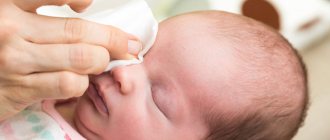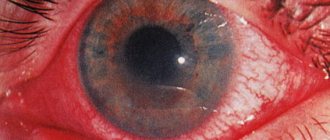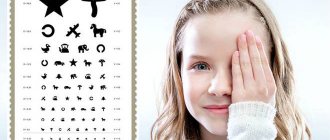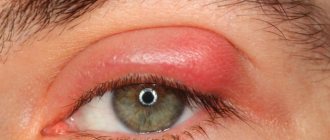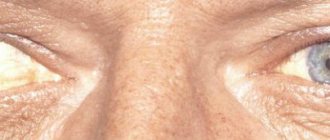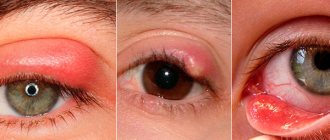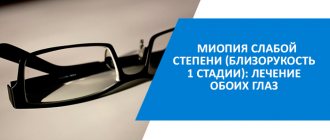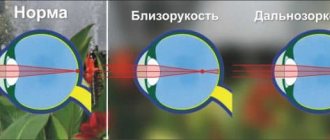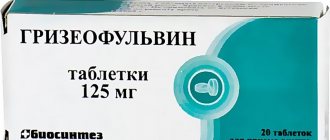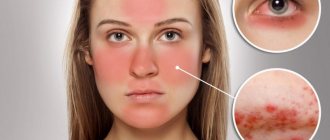Glaucoma is an eye disease in which intraocular pressure regularly increases (intraocular fluid accumulates and destroys the photosensitive cells of the retina). If left untreated for a long time, this pathology can lead to atrophy of the optic nerve and, as a consequence, complete blindness.
In addition to drug treatment, patients may be prescribed eye exercises. The effectiveness of gymnastic techniques is controversial. Please note that just doing the exercises does not guarantee you a complete recovery. But they will help relieve symptoms of fatigue and prevent pressure surges. Next, we will look at the basic methods of performing eye exercises for glaucoma.
General recommendations
Glaucoma can occur due to abnormal intraocular pressure (IOP). Depending on the form of the pathology, it can be either increased or decreased. Patients with elevated IOP, in addition to drug treatment, need to adhere to a diet and normalize their lifestyle.
To normalize IOP levels, follow these recommendations:
- Skiing, swimming, and fresh air help regulate intraocular pressure in the early stages of the disease.
- Experiencing strong emotional shocks, as well as nervous strain, negatively affects not only the psyche, but also the course of glaucoma.
- When staying in the sun for a long time, it is recommended to use sunglasses.
- Work that requires the head to be tilted down (washing floors, chopping wood, gardening) should be avoided. If you cannot completely get rid of such responsibilities, then you should make your work easier - use mops, low benches, etc.
- Diet: exclusion of fatty, fried, salty foods, as well as strong tea and coffee. It is recommended to give preference to lean meats, vegetable soups, dairy products, fruits and boiled fish.
- Monitor your body weight. Often people suffering from high blood pressure are overweight.
- A high pillow will help remove fluid stagnation in the organs of vision.
Exercising if you have glaucoma is beneficial, but exercise that involves lifting weights should be avoided.
Glaucoma causes. Treatment. Neumyvakin.
The cause of glaucoma lies precisely in the neck . If you put your head straight, there should be a bend at the back of the neck; if there is none, then this is a violation of the relationships of the vertebrae along with the vascular and venous system.
Neck muscles from the sides of the neck - use soft finger movements to determine the softness of the neck muscles; if hardness and soreness are detected, this is a spasm of all the muscles that compress arterial and venous blood.
The collar area is the back of the neck, from the sides and goes down to the shoulders, the upper part of the shoulder blades - you need to massage the shoulder muscles and it will hurt if there is a spasm in these muscles, they are like steel cables. And here is the circulatory system.
In a healthy state, normally, the muscles should be soft and there should be no pain.
General strengthening exercises
Therapeutic exercises for glaucoma are carried out with a patient who is relaxed, at rest, and not nervous. All kinds of stress and anxiety are strictly contraindicated. First of all, wait until your breathing stabilizes. During exercise, inhale through the nose and exhale through the mouth. You should gradually increase the depth and intensity of breathing.
You should start training the muscles of the ocular system from an early age in order to have excellent vision in adulthood or at least reduce the number of complications.
Exercise for glaucoma:
With such an illness, careful examination of paintings is useful.
- Examine a selected picture, house, building, carefully looking at all the little details.
- Slow/fast eye blinking.
- Close your eyelids and draw imaginary geometric shapes or write letters.
- Alternately perform circular exercises with your head with your eyes open, and then with your eyes closed.
- Look at the text, then quickly look at something else and try to find the starting position.
- Stretch your arms forward. Start moving them randomly and try to see the movements. If it doesn’t work, bring your hands closer.
What exercises help with glaucoma
It must be remembered that visual gymnastics should be performed daily. A standard set of exercises does not take much time and does not require a special environment. Typically, a course of gymnastics, which is recommended for glaucoma, includes only five exercises.
Before performing, you should do a breathing exercise. To normalize breathing, you need to start inhaling through your nose and exhaling through your mouth, gradually increasing your breathing frequency.
Exercises for glaucoma:
- You need to move your gaze over large objects, without peering into details and noting only general signs. You can't stop looking.
- You need to blink slowly, then close your eyes and make circular movements with your head. While moving, you should take turns opening your eyes.
- With your eyes closed, you should draw geometric shapes and write different words with your eyes.
- For this exercise, you need to mount a calendar on the wall. You should read a few lines, move your gaze to other objects and return to reading from the place where you left off.
- You need to stretch out your arms and move your fingers, watching the movements with your eyes.
Also, patients with glaucoma are recommended to count objects while walking (floors, signs, trees). It will be useful to count in different ways: from top to bottom, from bottom to top, from right to left. During the counting process, you need to look away and return to where you stopped.
Most exercises are based on viewing objects at different distances, which allows you to train different modes of vision. By nature, the visual system is designed to provide distance vision, so when working with small details, the eyes get tired faster. Exercises help train your eyes and increase the time before they become overstrained.
It is important to remember that exercise does not cure glaucoma, only stop its progression and prevent complications. Ophthalmologists can recommend different exercises, since there are many proprietary techniques. Exercises developed by Troitskaya, Norbekov, and Demirchoglyan are suitable for the prevention of glaucoma and other pathologies of the visual system.
Gymnastics helps normalize the circulation of intraocular fluid, thereby reducing the load on the optic nerve. As monotherapy, gymnastics is almost ineffective, so for glaucoma you need to use medications and establish a special diet. After treatment of glaucoma, you can continue gymnastics as before. This helps to consolidate the results, reduce eye strain and improve visual acuity.
Types of visual gymnastics
The selection and frequency of visual gymnastics must be agreed upon with the attending physician. Otherwise, you risk making the situation worse. It is important to understand that gymnastics in itself is not a panacea and only it will not save you from pathology. But in combination with medications you will get a positive effect.
According to Bates-Zhdanov
Visual gymnastics for the eyes according to the Bates-Zhdanov method is carried out as follows:
- Direct your gaze upward (1 sec), and then relax your visual organs.
- Look to the right for 1 second, and then to the left;
- Figuratively draw a rectangle shape, first clockwise and then back.
- Make rotational movements with your eyes in a circle, while stopping your gaze on the right, left, above and below.
- Figuratively depict a snake with the organs of vision (first in one direction and then in the other direction).
- Direct your gaze into the distance and focus it on one point.
- Using your index finger, gradually move your hand closer to the tip of your nose. Then repeat the exercise with the other hand.
Exercises should be done in moderation. Do not exceed the number of repetitions prescribed by your doctor. Close your eyes 25 times.
According to Norbekov
Mirzakrim Norbekov has developed a number of exercises that help people with various diseases of the organs of vision. However, with macular degeneration, glaucoma, cataracts or optic nerve atrophy, healing should not be expected, but vision can be maintained in the form in which it currently exists. The scientist advised performing gymnastic exercises while maintaining the muscle corset (straighten your shoulders, straighten your back, relax and get down to business with a smile).
A set of exercises according to Norbekov:
- keep your head straight, look up, and then mentally continue the line;
- hold your head in the same way, look down and imagine that it has reached your own throat;
- look to the left and imagine that your line of sight has penetrated into your very ear, do the same with the opposite side;
- butterfly: the head should remain motionless, draw with your eyes an image as large as possible, within the boundaries of your view. You should start from the lower left corner, then look to the upper right corner, then direct your gaze to the lower right corner, and finally to the lower left;
- eight. You should draw an infinity sign or an inverted number 8 with your eyes. You should do the exercise gradually, after finishing it, close your eyes and let them rest;
- fix the index fingers of both hands on the nose and gradually move them apart. The right eye should follow the index finger of the right hand, and similarly with the other hand. It is important to take into account that you should not separate your visual organs when performing this exercise - you only need to use your peripheral vision. After completing this technique, you should give your eyes some time to rest.;
- mentally imagine a golden-colored wall clock and move your eyes clockwise in a circular motion. It is necessary to hold your gaze on each unit of the dial. Each workout involves increasing your figure size. You can repeat the exercise while looking at the sky (with your eyes open). Next, it is important to close your eyes and repeat the procedure with your head straight (it helps to massage the lens).
According to Norbekva's recommendations, gymnastics should be performed regularly. Its effectiveness increases if you follow the principle of performing the exercise first with your eyes closed and then with your eyes open, after which you need to mentally repeat what you have done.
According to Neumyvakin
Visual gymnastics, according to the scientist, leads to stabilization of intraocular pressure. If a person feels painful and uncomfortable sensations, then he should consult an ophthalmologist in order to identify the cause of the deviations.
To relax muscles
Exercises should be performed gradually, one after another, making sure that the eyes are comfortable. Before starting the procedure, it is recommended to massage the eyelids, close your eyes with your palms (there is no need to put pressure on the organs of vision), and then wash your face with water at room temperature.
A set of exercises according to Neumyvakin:
- Look down for 5 seconds, then blink your eyelids quickly. Do the same exercises while looking up.
- Look to the left, blink intensely for 5 seconds, and then look in the opposite direction.
- Draw the letter X with your eyes: look at the upper left corner, then at the lower right, then at the upper right, and then at the lower left corner.
- Circular movements 15 times clockwise and 15 counterclockwise.
- Look at the nose with both eyes, relax your gaze. The number of exercises is 5 seconds.
- Close your eyes and hold your eyes in this position for 5-6 seconds, open your eyes.
The last exercise is performed using glass: the patient looks into the distance and focuses on the farthest point, and then looks at the glass. Thus, two indicators of viewing an object at a distance and near immediately alternate.
To improve blood circulation in the eyes
To stimulate blood flow to the eyes, you should adhere to the following techniques:
- Close your eyes and then blink intensely.
- Open your mouth wide, after which you need to squeeze it tightly (the exercise is performed about 6 times).
- Do the following step by step: close your eyes, squint your eyes, relax your visual organs, open your eyes.
According to the Bates/Zhdanov method
- We look up for a second;
- Then right, left - one second at a time;
- We move our gaze up to the right, down to the left;
- Now it’s the other way around: left and up, right and down;
- We draw an imaginary rectangle in the air with our eyes. First in one direction, then in the opposite;
- We draw an imaginary dial - fix our gaze on the numbers 12, 3, 6, 9. Repeat in reverse order;
- Right hand in front of you, look at the tip of the index finger. Slowly move your hand towards your face, without taking your eyes off your finger. We bring our hand to our nose, then also slowly move our hand back;
- We look at the farthest point outside the window;
- We draw a snake with our eyes, first from right to left, then in the opposite direction.
- We close our eyes 20 times in a row.
IMPORTANT : At the end of the complex, you should let your head and neck relax - make several rotational movements and bends.
Additional Tibetan gymnastics exercises for eyes with glaucoma.
Tibetan eye gymnastics for glaucoma is the same set of exercises as for myopia. But in addition to the exercises described above, perform others aimed at reducing intraocular pressure and improving retinal nutrition:
- Apply stroking for 2 minutes to the brow ridges, from the middle of the forehead to the temples.
- Using the pads of your index fingers, stroke your forehead from the middle to your temples at the hairline.
- Make massaging circular movements to your temples for 2-3 minutes.
- Perform light tapping with your fingertips for 3 minutes.
Perform circular movements with your eyes 10 times, first clockwise, then counterclockwise.
Additionally, perform the exercises that are described for the prevention and treatment of myopia.
Exercises according to Norbekov
Thanks to this technique, thousands of people have forgotten about glasses. For glaucoma, exercise helps restore vision. Norbekov's technique is based on self-hypnosis. Gymnastics for the eyes gives excellent results.
You should not expect a cure for glaucoma, although Norbekov is trying to prove the effectiveness of the technique even with such irreversible damage to the optic nerve, which glaucoma leads to.
Norbekov complex:
- Do a warm-up. Rotate your eyes, mentally draw lines up/down/left/right.
- Draw a butterfly with eyes. Make movements in the following order: left down - right up - right down - left up. Repeat the exercise in the opposite direction. Finish by blinking rapidly for 30 seconds.
- Mentally draw a figure eight, including only the eyeballs in the work. Make the circles as large as possible, go beyond your own comfort, but do not exercise through pain. Do not go beyond the face. Overvoltage must not be allowed.
- Look at the tip of your nose. Shift your gaze in front of you, fixating on the side objects, but do not move them.
Massage to reduce intraocular fluid pressure
After completing visual gymnastics, it is recommended to do a massage in order to relax the muscles and also improve blood flow to the eyeballs.
The massage should be performed carefully, without excessive pressure.
Several massage techniques:
- The first technique is as follows: use your fingertips to move along the superciliary area from the bridge of the nose to the temples (in this case, the skin should be slightly squeezed until a sensation of muscle relaxation occurs);
- Next, you should use your fingertips to rise above the eyebrow line and massage the forehead area;
- massage the corners of the eyes in a circle;
- Use stroking movements to move the nasolacrimal duct (from the inner corners of the eyes to the nose);
- close your eyes, press your fingers on your eyeballs 6-7 times and hold for about 3 seconds each time;
- “hammer” technique: spread and bend your fingers, and then lightly tap them on your forehead;
- stroke the temples clockwise (4 minutes).
The duration of massage techniques does not exceed 10-15 minutes. It is important to remember that any of the above exercises should not cause any pain or discomfort.
After finishing the massage, it is recommended to twist your neck and shoulders in a circular rotational motion.
Massage for eyes and eyelid area
Helps reduce IOP by improving lymph and blood flow. If in the morning, while washing your face, you rub your forehead more intensively, blink and raise your eyebrows, then blood circulation will increase in the eye area and your gaze will become more alert.
Method of massage:
- Start by stroking from the center of the forehead (between the eyebrows) to the temples. Rub with fingertips. Then go back and make tapping movements over the entire frontal part.
- Press on points along the entire surface of the brow ridge, then to the right and left of the bridge of the nose and in the outer corners.
- With severe asthenopia, it is easy to press on closed eyelids. Make vibrating movements 5–10 times. This helps reduce swelling and eliminate headaches.
It is recommended to undergo lymphatic drainage technique from a specialized massage therapist. Increases endurance, prevents deterioration of visual perception, and relieves swelling.
After completing the massage, it is recommended to wipe the treated area with an ice cube.
conclusions
- Visual gymnastics is a common practice in the treatment of ophthalmological diseases. It is not able to completely rid a person of pathology, but maintaining visual acuity and toned eye muscles is quite possible.
- To eliminate glaucoma, it is important not only to do exercises regularly, but also to take medications prescribed by your ophthalmologist in a timely manner, and adjust your diet and daily routine.
- Among the main gymnastic techniques, the following types of visual gymnastics are distinguished: according to Bates-Zhdanov, according to Norbekov, according to Neumyvakin.
- After completing the exercises, it is recommended to do an eye massage.
The essence and basic signs of eye gymnastics
Gymnastics for the eyes using various methods is one of the most popular and effective methods of preventing and restoring vision; moreover, it is easy to perform and does not require any special devices or preparation.
There are many different exercises, but gymnastics based on the principles of Norbekov, Avetisov, Zhdanov and Bates have long proven themselves, demonstrating the best results.
Method of Mirzakarim Norbekov
The main essence of Mirzakarim Norbekov's method lies in the psychological state, because he believes that attitude, mood and confidence are very important recovery processes. Stop perceiving yourself as sick and weak is one of his main slogans in his books.
High positive results are shown by exercises in the treatment of myopia, astigmatism and farsightedness. The author himself determines the approximate recovery time for 1 diopter: from 4 to 7 days, and strongly recommends that all exercises be carried out with a smile, a positive attitude and peace within.
Method of Eduard Sergeevich Avetisov
The basis of all sets of exercises includes the prevention of not only the eye itself, but also processes that directly relate to the visual. For example, there are techniques designed to strengthen the eye muscles, improve blood circulation around the eyes, or improve accommodation.
Treatment methods according to Avetisov are often prescribed to children, because at this age it is very easy to control and prevent vision.
William Horatio Bates Method
The main postulate in the Bates method is relaxation of the whole body, in particular the eye muscles, as well as the rules of breathing, nutrition and physical activity.
Bates believed that everything in the human body is interconnected, and in order to achieve results in eye treatment, you need to take care not only of them, but also of the body as a whole. The principles of Bates treatment restore the tone of the eye muscles, improve blood circulation, and also treat pain and stinging in the eyes.
Method of Vladimir Georgievich Zhdanov
As in the Bates method, a fundamental aspect of exercises according to the Zhdanov method is to relieve stress from the eyes and eye muscles. Many exercises improve blood circulation not only around the eyes, but also in the brain. It is also recommended for people who do not have vision problems, but have a job in which their eyes get tired and strain a lot.
Causes and symptoms of glaucoma
The pressure inside the eyes - IOP - can increase due to disruption of the lacrimal glands and increased production of intraocular fluid. As a result, moisture accumulates inside the eye, creating excess pressure. The situation may be aggravated due to disruption of the tear secretion process: blockage of the channels through which fluid flows from the eyes leads to an even greater increase in IOP.
Increased pressure causes the eyeball to enlarge, which begins to put pressure on the optic nerve, damaging its tissue. The greater the pressure, the faster the optic nerve is destroyed. Its partial atrophy leads to serious and irreversible impairment of visual function.
Complete death of the nerve causes blindness, which cannot be cured even with the most modern surgical techniques.
Therefore, the main task in the fight against glaucoma is the timely detection of pathology and taking measures to reduce IOP.
As a rule, glaucoma develops in people after 40 years of age. The following factors can lead to the development of the disease:
- Eye injuries.
- Displacement of the lens.
- Diabetes.
- Alcohol abuse, heavy smoking.
- Tumors.
- Congenital disorder of the structure of the eye structures.
- Atherosclerosis of eye vessels.
- Inflammatory diseases of the organs of vision - keratitis, uveitis, scleritis.
- Long-term use of certain medications.
- Cataract.
- Unsuccessful eye surgery.
- Dystrophic processes – hemophthalmos, iris atrophy.
To avoid the development of pathology, people over 40 years of age need to undergo regular preventive examinations with an ophthalmologist. This is especially important for those who have close relatives suffering from glaucoma.
If symptoms appear that could indicate the development of this dangerous disease, you should immediately consult an ophthalmologist.
Signs of glaucoma include:
- Narrowing of the visual field and the occurrence of other visual defects, which may be caused by dysfunction of the optic nerve.
- Painful sensations in the eyes.
- Headache.
- Increased tear production.
- The appearance of multi-colored circles when a person looks at the light.
Some patients may develop photophobia, a condition characterized by severe discomfort, watery eyes, and pain when looking at bright lights.
What is glaucoma. Neumyvakin.
Briefly recorded with video. The eye is an optical system. The vitreous body is glass that transmits light and then, with the help of electrical impulses, this light is converted into color energy and what we see and understand.
Waste from undigested food due to improper food intake, which we wash down with liquid drinks, and the liquid dilutes the digestive juices; subsequently, the food is not completely processed and is deposited with fat and waste in the body.
This negatively affects the vitreous body of the eye lens and cataracts ...
Glaucoma. The operation won't help. Neumyvakin.
Glaucoma is an increase in intraocular pressure.
An artery and vein pass through the opening in the orbit and the optic nerve emerges from there. The optic nerve passes through the entire mass of the brain and goes to the optic thalamus, which is located in the back of the head.
There are no valves in the brain and the vascular system works completely differently. The vascular system is completely dependent on what happens in the brain.
As intracranial pressure increases, outflow from the eye decreases. The primary cause of glaucoma is not in the eye, but starts in the neck.
Compression of the veins at the level of 4 - 5 vertebrae (due to systematic tilting of the head during work and, over time, straightening of the spine), an increase in intracranial pressure is created, where the vein passes into the eye and subsequently it creates a condition of intracranial pressure.
The process of degeneration and disruption of the trophism of the optic nerve, which is constantly exposed to intracranial pressure, leads to the fact that these people go blind. Surgeries and medications do not help these people.
Ophthalmology is associated with the vascular network, with muscles, i.e. with the entire body...Glaucoma does not lie in the eye, but deeper - in the brain and neck...
After 30 years, many people's neck requires special attention. The body must always be in harmony internal and external.
Palming
This is the name of the procedure that allows you to relieve tension from the eyes. It is recommended to do it before starting gymnastics. You need to get comfortable and relax as much as possible. Place your elbows on the table and rub your palms.
Close your eyes, press your palms against them, but without strong pressure. The fingers should meet on the forehead. First, flies and spots of color will flash before your eyes. Gradually they disappear, absolute darkness appears. This means that palming was carried out successfully.
To watch a video about the correct technique for performing palming for the eyes:
How to relax your eyes after prolonged stress?
Gymnastics for glaucoma can relieve eye strain, but it does not affect the cause of the disease. Those patients whose work requires eye strain are advised to perform relaxation exercises from time to time. First you need to stroke your temples in a circular motion, then start lightly tapping your fingers on your forehead.
Next they use their eyes: close them tightly and open them. All actions should be repeated ten times, being in a comfortable position. You need to continue the complex by blinking frequently for two minutes.
The next exercise involves alternately focusing your gaze on distant objects outside the window. Finally, take a pencil or pen and place the object at arm's length. You need to alternately focus your gaze on distant objects and on the pencil.
Before starting gymnastics, inhale air through your nose and exhale through your mouth.
- "Exploring the World." Look out the window and start looking at a building. Pay attention to any little details: how door and window openings are designed, balconies, what curtains hang on the windows. Keep your gaze constantly moving throughout the building.
- "Innocent eyes" Blink slowly. Closing your eyelids, tilt your head forward and back. Open your eyes one at a time so that you can blink them one at a time.
- "Free artist". Closing your eyes, imagine that your nose is a brush. Draw a figuratively large square, and then try to fit a circle, letters, words into it.
- "Points of view". The peculiarity of the exercise is in switching attention, focusing vision on other objects. Hang a poster or calendar on the wall, start reading the information, and then periodically get distracted and look out the window.
- "Peripheral vision". Extend your arms in front of you and start moving your fingers. If you can’t distinguish the movements, move your hands closer to you.
Perception stimulation is one of the most effective methods of vision restoration. Our eyes record everything they see and send signals to the brain. It analyzes and saves the information received. Then he decrypts the saved image and gives us the picture that we saw. For example, we easily recognize a familiar person by his silhouette, gait, manners and hairstyle.
The basis for such recognition is laid in childhood, when the child begins to recognize his mother and the objects being studied. Unfortunately, with glaucoma, a person has no desire to look at objects. But this must be done, since the development of perception helps to cope with the sad consequences of the disease. There are special exercises for this. They need to be performed regularly, and not from time to time.
Before you start charging, inhale air through your nose and exhale through your mouth. We breathe calmly and evenly. Only after this we begin to study. For greater effect, imagine that we are on stage and show others how to do therapeutic exercises for the eyes correctly. This will bring not only benefits for glaucoma, but also pleasure!
Exploring the world around us
Through a window or while on the street, we select an interesting building and begin to study it. We look at how the doors and windows are built in, who has what kind of curtains hanging, what interesting things are on the roof, etc. If you see a sign with a street name and house number, then we try to distinguish every letter and number on it. At the same time, we don’t stop looking for a minute. We constantly move it throughout the building.
You can start looking at passers-by, who is wearing what, facial expressions, body features, etc. At the same time, we imagine ourselves as a famous artist choosing a sitter to create a new portrait. And if we imagine that we are going to draw a landscape, then we find some interesting tree, study its structure, branches, leaves.
"Innocent Eyes"
Performing an eye exercise involves blinking, which is their natural way of moisturizing. Alternately open and close your eyes. Let's do it slowly. With your eyes closed, tilt your head forward and back, then open each eye in turn. Open it slowly so that you can blink your eyes one at a time.
"Freelancer"
On a piece of paper, draw the letter “E” in large letters with a black marker. We carefully examine the lower, middle and upper parts of the letter. We remember the image. We move away from the drawing about two meters, looking at it, we blink several times. We repeat until the letter becomes clearly visible.
Another fun exercise for the eyes - close your eyes, imagine that your nose is an artist’s brush and figuratively draw a large square. Then we try to write a circle, a number, and our name into it. We carefully print each letter.
"Different Points of View"
Extend your index finger and rotate it clockwise, and then counterclockwise. At the same time, we continuously monitor the movements of the finger with our eyes. Opposite your favorite place for reading, we hang a calendar or a poster with large letters on the wall; if possible, we hang a check table.
Performing the exercise
While reading, no, no, we are distracted and look at the “hanging” object. When reading during the day, you can look out the window. There is another exercise for the eyes that can be performed while reading. It involves remembering the last word you read. After memorizing, we imagine white space around black-black letters.
Without straining our eyes, we look at the word again and rotate our eyes around it. With this exercise, your eyes will get used to focusing quickly and will not get tired. Stimulating peripheral vision is equally important. We stretch our arms and move our fingers. If the movement is not discernible, then we bring our hands closer to ourselves.
Contraindications to gymnastics
Gymnastics is useful for the prevention of cataracts, glaucoma, and some other vision problems. But in a number of conditions, eye gymnastics can be harmful. Contraindications to exercises:
- retinal disinsertion;
- traumatic injury;
- high degree of myopia;
- condition after laser treatment;
- infectious and inflammatory diseases of the visual organ.
During pregnancy and breastfeeding, as well as in childhood, eye gymnastics is not contraindicated.
The time required to perform any type of gymnastics is 10–15 minutes. Do the exercises daily. Remember that eye gymnastics cannot cure cataracts. It will only slow down the changes in the lens. The radical method of treating cataracts is surgical treatment.
Share your knowledge about gymnastics for the visual apparatus for cataracts. Share the article on social networks. Take care of your eyesight. All the best.
source
Indications for starting the use of eye gymnastics
Gymnastics for the eyes according to the methods of Norbekov, Beist, Zhdanov and Avetisv will be effective for:
- myopia;
- farsightedness;
- age-related degenerative changes in the eyeballs;
- astigmatism;
- cataract;
- weakness of the eye ligaments;
- strabismus;
- glaucoma;
- hypermetropia;
- severe fatigue of the eyes and the entire visual apparatus.
For myopia, eye gymnastics will help strengthen the eye muscles, rebuild them in the right way and gradually restore vision.
During farsightedness, eye gymnastics can significantly slow down this process for older people; it also helps improve blood supply to the cervical spine and stimulate the lens, thereby restoring the ability to focus.
For people with astigmatism or cataracts, eye gymnastics will help by increasing metabolism in the eye tissues and supplying the eyes with the necessary oxygen and nutrients. It will also improve adaptive functions and accommodation.
It should be remembered that it is best to consult a doctor before choosing one or another technique. In some cases, treatment will be based only on eye gymnastics, but there are also cases where gymnastics is only one of several steps of treatment.
Gymnastics according to Bates
A set of exercises according to the Bates method is based on visualization. Thus, patients with glaucoma are recommended to draw imaginary horizontal and vertical lines with their eyes, and outline figures, for example, a circle or a triangle. The set of exercises also includes drawing a snake, a clock dial and a hand moving from one number to another.
When performing such exercises, you must keep your head still. Before doing eye exercises, you should stretch your neck muscles and perform 5 bends forward, backward, left, and right.
Exercises according to Neumyvakin
Doctor of Medical Sciences Neumyvakin I.P. believes that the problem can be solved by cleansing the body and special exercises. Offers the following set of exercises to stabilize IOP:
- Wash your face with cool water and lightly massage your eyelids. Palming and completely relax.
- Look up and fixate for 5 seconds. Relax and slowly look down until your eyes completely roll back.
- Do the same, just look left and right. Try to look behind you without turning your head.
- The technology doesn't change. The head is motionless, only the organs of vision are included in the work. It is necessary to alternately direct the apples to different corners. Drive diagonally.
- Bring the organs to the nose and relax. If discomfort occurs, stop the exercise.
- Blind Man's Bluff. Relax the oculomotor muscles by closing your eyes. Open after 5 seconds.
Neumyvakin recommends doing an exercise with glass for glaucoma. Draw a point and find the object behind the glass. First concentrate on the mark, then turn your gaze to a distant object.
Opinion about eye exercises for doctors and patients
Gymnastics for the eyes according to the methods of Norbekov, Bates, Zhdanov and Avetisov are most often prescribed by ophthalmologists. In most cases, the doctor helps you choose the right exercises and their frequency, timing, or prescribes individual exercises, depending on the disease.
In addition, eye exercises are often prescribed not so much for treatment as for prevention and preventive protection of vision. According to statistics, every 3rd ophthalmologist recommends some gymnastics exercises for the eyes.
To find out the opinions of patients, a large-scale survey was conducted on forums dedicated to eye problems, shown in the table:
| Percentage of respondents | The effect of gymnastics for the eyes |
| 51% | Helped and had a noticeable effect |
| 20% | Helped with myopia, but the effect was slow |
| 10% | Helped stop vision deterioration, stopped the process |
| 19% | Didn't help and didn't bear any fruit |
For any study with a large sample, 51% is a huge number to demonstrate effectiveness.
Treatment with Soda and Hydrogen Peroxide According to Neumyvakin - How to treat glaucoma of the eye
July 12
Professor I.P. Neumyvakin is a luminary of Soviet medicine who developed methods for treating cosmonauts in spaceship conditions. His task was to find out what medications could be used during flights in case of illness. It turned out that there were none.
This fact forced Professor Neumyvakin to reconsider his attitude towards drugs and look for means that can ensure the health of the body, both on Earth and in space. The result of the scientist’s many years of work was a method for treating diseases with soda and hydrogen peroxide.
The essence of Professor Neumyvakin’s technique
Let’s say right away that the method under consideration has many opponents, and therefore today there are fierce debates in the scientific world as to whether it is possible to treat diseases with such simple and publicly available means. Nevertheless, Professor Neumyvakin’s theory has the right to life and here’s why.
The essence of the theory is that the vast majority of diseases in our body develop against the background of a violation of the acid-base balance, as well as its contamination of the body with waste and toxins.
In this regard, sequential intake of soda and hydrogen peroxide allows you to:
- bring the blood formula back to normal;
- saturate cells with oxygen;
- improve metabolism;
- improve liver function;
- dissolve kidney stones;
- rejuvenate body cells;
- neutralize excess cholesterol;
- remove waste and toxins from the body;
- cope with allergic reactions;
- regulate the level of certain hormones;
- destroy cancer cells at an early stage of cancer.
According to the professor, these substances have a comprehensive effect on the body, which means they can replace hundreds of expensive drugs in the event of a variety of diseases. Below we will tell you how to take soda and peroxide correctly, and give the most valuable recipes from Professor Neumyvakin.
Scheme for taking soda and hydrogen peroxide according to I. P. Neumyvakin
It is prohibited to use soda and peroxide at the same time, because in this case the substances simply neutralize each other’s effects. They must be taken separately, after a certain period of time (30–60 minutes).
1. In the morning at 1 tbsp. l. add 1 drop of peroxide to warm boiled water and take on an empty stomach. Do not eat food for 30 minutes. After the allotted time, drink a glass of water with soda diluted in it, taken on the tip of a knife. Perform this procedure 3 times a day, before meals.
2. These medications should be taken for 10 days. At the same time, every day increase the amount of peroxide by 1 drop and soda by a particle. In this case, by the last day of the course, the amount of peroxide taken at one time should reach 10 drops, and the amount of soda should reach 1 tsp.
This treatment will allow you to cleanse your body and establish the acid-base balance, preventing the development of acidosis (acidification of the body) and thereby saving you from many diseases. However, practice shows that such treatment does not help everyone. Why is this happening?
Mistakes made during treatment
1. Wanting to get a therapeutic effect as quickly as possible, a person begins to increase the concentration of soda too quickly. As a result, instead of treatment, the body receives shock, with all the ensuing consequences in the form of indigestion and diarrhea.
Add soda a little at a time, listening to the state of your body. In response to the dose, a rash may appear on the body, blood pressure may rise, or there may be no reaction.
The body just needs to be given time to get used to the dosages of the substances in question.
2. Sometimes after taking peroxide and soda, a person experiences belching and bloating. This indicates that the soda has reacted with the food being digested. To avoid such unpleasant symptoms, procedures should be performed exclusively on an empty stomach.
3. Water for the solution should be boiled and slightly heated. Cold water is not suitable for such procedures, since in this case the body spends a lot of time absorbing it. Water 35–40°C will be optimal.
By the way, the products in question in initial doses (1 drop of peroxide per teaspoon and a pinch of soda per glass of water) can be used constantly, throughout your life.
The main thing is to do this in the morning, on an empty stomach. This procedure will not harm your health; on the contrary, it will bring great benefits.
By the way, in the monasteries of Tibet, monks throughout their lives take water on an empty stomach with a particle of soda diluted in it.
However, treatment with hydrogen peroxide and baking soda is often done separately rather than together. Below are several valuable treatment recipes using such remedies.
Treatment with hydrogen peroxide
Treatment of flu and colds
Having hydrogen peroxide on hand can speed up the treatment of colds. To do this, take a tablespoon of boiled, lukewarm water and add 6 drops of peroxide to it.
Take the prepared solution into a syringe without a needle and inject half a portion into each nostril. Apply drops to your nose in this way 3-4 times a day.
And to enhance the effect of this remedy, after the first morning procedure, eat a spoonful of honey.
Treatment of runny nose and sinusitis
Hydrogen peroxide also copes well with such a serious problem as sinusitis. Boil water and cool it to 35°C. Add 30 drops of the product in question to a glass of water, and pour the finished mixture into a syringe or teapot.
With your head tilted over the sink, begin pouring liquid into one nostril so that it flows out of the other nasal passage. Change nostril and repeat the procedure.
Carry out rinsing 3-5 times a day and soon the unpleasant signs of sinusitis will stop bothering you.
Rinsing and inhalation for laryngitis and tonsillitis
In case of inflammation of the tonsils or the appearance of adenoids, take 240 ml of boiled water and dissolve 20 ml of hydrogen peroxide in the cooled liquid. Fill another glass with chamomile decoction. Gargle first with water and peroxide, and then with chamomile infusion. Treat a sore throat with these remedies 1–3 times a day.
Treatment of nail fungus
To cope with the fungus that destroys nails, you need to dilute 100 ml of peroxide in 2 liters of warm water, then pour the liquid into a basin, lower the foot with the affected nail into it, and hold for 20-30 minutes.
After the procedure, when the nail is wet, take nail scissors and remove the affected part of the nail and file it with a nail file. Carry out the procedure daily until the fungal infection completely disappears.
Treatment of papillomas
Nevi and papillomas can be easily removed without surgery or cauterization with celandine. To do this, simply soak a cotton swab in 3% peroxide and thoroughly lubricate the new growth. Carrying out the procedure 5–7 times a day, after two weeks you will notice that a crust has appeared on top of the papilloma, and the formation has begun to dry out. After about a month of such procedures, the nevus or papilloma will completely disappear.
Douching for female diseases
Inflammation of the cervix, emerging erosion or thrush can be eliminated using an inexpensive but effective remedy called hydrogen peroxide.
Preparing the medicine will not take you much time: take 220 ml, dilute 20 ml of 3% peroxide in it. Having collected the solution into a syringe, insert it into the vagina and inject it inside.
These procedures should be carried out in the morning and evening until all unpleasant symptoms disappear.
Treatment of prostatitis
Similar to female diseases, peroxide also eliminates male problems, in particular, treats prostatitis.
In this case, a similar solution is prepared (220 ml of water per 20 ml of product), after which the mixture is taken into an enema and introduced into the patient’s anus. True, you should first do a cleansing enema.
Such manipulations should be carried out once a day, before bedtime. This will reduce pain when urinating and reduce the number of night trips to the toilet.
Treatment of hemorrhoids
The remedy discussed above will also help cope with internal hemorrhoids. Just douche morning and evening, and after 1-2 weeks you will notice that unpleasant symptoms during bowel movements no longer bother you.
And if you have external hemorrhoids, soak a bandage folded in several layers in this product and apply it to the anus for 20-30 minutes, at least once a day.
By the way, you can also cure anal fissure with this remedy.
Treatment of hearing loss
Such a serious hearing problem as hearing loss can be treated with an undiluted solution of hydrogen peroxide. Take a little 3% peroxide into a pipette, lie with your healthy ear on a pillow so that the affected ear is on top, and drop 3-4 drops of the product into it. Don't worry if white foam starts to appear from your ear. This is quite normal. Apply instillations twice a day.
Glaucoma treatment
Peroxide is also suitable for the treatment of ophthalmic diseases, particularly for the fight against conjunctivitis and glaucoma. True, this will require a weak 0.5–1% peroxide solution. In 1 tbsp. l. Dilute this product in 6 tablespoons of boiled water, then take the solution into a pipette and drop 2 drops into each eye three times a day.
Treatment of hypertension
To combat high blood pressure, you will need to carry out treatment according to a special regimen. To do this, on the first day in the morning on an empty stomach, drink a glass of boiled water with 1 drop of peroxide diluted in it. Increase the amount of product by one drop daily.
After 10 days of treatment, take a week's break, and then dilute 10 drops of hydrogen peroxide in a glass of water and take this solution for two days. Take a three-day break and again take a glass of water with 10 drops of peroxide in the morning for two days.
Continue treatment according to the regimen of 2 days on and 3 days off until the unpleasant symptoms disappear.
Source: https://glaukoma-lechenie.ru/lechenie-sodoj-i-perekisyu-vodoroda-po-neumyvakinu/
